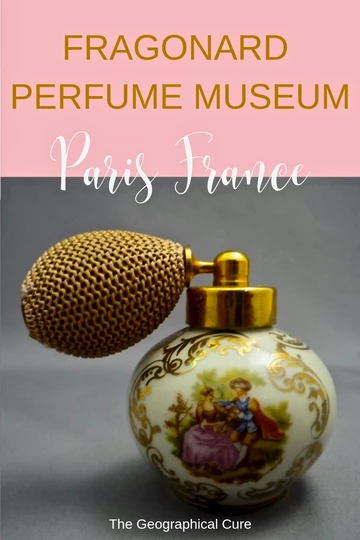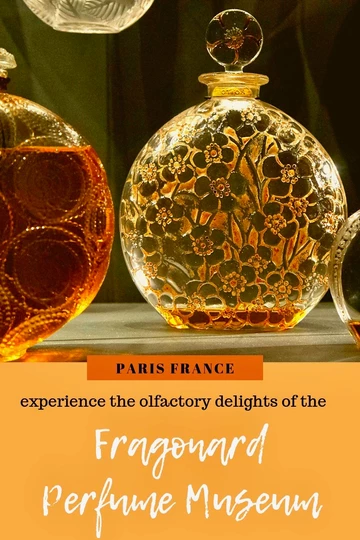I grew up at a time when girls were supposed to wear perfume. I never did.
I used to dread department stores. It was virtually impossible to avoid the cosmetic section. Perfectly coiffed and high heeled ladies would bustle toward me with their perfume nozzles, and I would flee.
I don’t think it’s an allergy per se. But strong floral scents make me sneeze. And when I sneeze, it’s like an iPhone on burst mode. I sneeze a zillion times, always drawing stares.
My daughter asked me on our last trip to Portugal why I sneezed that way. How do I know? And, besides, what’s a girl with a sensitive nose supposed to do?
It might not have been practical given my condition. Nonetheless, on impulse one day while visiting the L’église de la Madeleine in Paris, I popped into the nearby Fragonard Musée du Parfum. My youngest daughter, a beauty guru, adores perfume. I had lofty visions of a surprised and delighted smile on her face if I procured a fragrant trinket.
A Romantic and Fragrant Museum
The Fragonard Museum is nestled in the heart of Paris, a half block from the Opéra Garnier. The museum opened in 1983. It’s outlasted other wannabe perfume museums in Paris.
The Fragonard Museum is housed in a romantic and ornate 19th century Napoleon III townhouse in the 9th arrondissement. It has no pretenses to modernity; it’s meant to be an old world sensory voyage.
The townhouse was built in 1860 by Joseph Lesoufaché, a student of Garnier, for whom the nearby Opera Garnier was named. The decor is sensuous and alluring with painted ceilings, stucco decoration, old fireplaces, and crystal chandeliers — everything you’d expect from a luxury brand in a luxury setting.
History of the Museum & Perfume
Fragonard is a French perfume company founded by the entrepreneur Eugène Fuchs in 1926. Based in Grasse, Fuchs’ plan was to create and sell high end perfume products to wealthy tourists flocking to the Riviera. The company prospered and expanded to Eze and Paris.
Fragonard makes and sells its products only in France. It doesn’t even advertise, it’s so well known. And it’s still a family business. Now, Fuchs’ great granddaughters, Agnès and Françoise, are at the helm.
The museum’s Paris location is full of the historic character that Fuchsin loved. It was once a theater, home to fanciful ballets. Then, it was converted to a bicycle merry-go-round.
The name Fragonard was given to the perfume house in honor of the Rococo society painter Jean-Honoré Fragonard. Fragonard was born in Grasse, a small town on the French Riviera. Grasse is considered the cradle of French perfumery.
In fact, France has been a world center for the perfume trade since the 17th century. Louis XIV, the Sun King, was known as the “sweetest smelling king of all.” The perfume addict’s court at Versailles was so fragrant that it became known as “le cour parfumee.” All that perfume covered up some seriously poor hygiene and a fear of bathing.
If that back story isn’t enough to entice you, there’s extra incentive. The museum is free and offers a 30 minute guided tour in multiple languages.
The Perfumery Collection
The collection is mostly the brainchild of Jean-François Costa, the grandson of the founder of Fragonard.
He was an art collector. In the 1970s, Costa began collecting perfumery objects. He decided to open a perfume museum to showcase his collections and, most deliciously of all, to reveal the secrets of the mysterious world of perfumery. A world about which I knew shockingly little, perhaps due to my youthful department store experiences.
The tiny museum is unique and rather magical. Costa’s collection of precious objects traces the history of perfume from antiquity to the present day.
Visitors will find cabinets of curiosities, including ancient artifacts, perfume “organs,” scent boxes, test tubes, blown glass bottles that look like precious jewels, and potpourri used at the court of the Louis XIV.
The perfume bottles come in every variety. Some are in the shape of a whistle, or foot, or a head. Perfume was sometimes carried in a ring flask. There are intricately etched designer bottles.
One interesting object was a pommander. It was worn, superstitiously, on a belt or as a pendant. It was supposed to ward off illnesses or epidemics so common in the middle age.
You will learn that the Iris is the most expensive flower to make perfume from and that light, heat and air are the enemy of perfume. That Fragonard glass bottles are patented and specifically designed to preserve the fragrance’s potency and longevity. An average bottle of Fragonard perfume can last 2-3 years.
At the end of the tour, you can put your nose to the test in the “sensory experience” room. It’s an olfactory guessing game. You can smell the scent, sprayed on a piece of paper, and try it guess the identity.
I didn’t excel at this game. I definitely don’t have the requisite “nose” for a perfume aficionado and marketer.
In 2019, the museum recently expanded to include 3 more rooms and over 100 new objects, including new flasks from the 17th and 18th centuries. The new pieces were sourced from auction houses, antique stores, and private collections.
The museum has also added sumptuous decor — salon style paintings on red walls and glass cabinets for the new object d’arts.
One of the new rooms walks viewers through “raw materials.” It explains how perfumes are made from flowers, herbs, moss, leaves, spices, and other ingredients. It also covers the history of perfume in Grasse. There’s even a short film explaining perfume packaging and marketing.
At your visit’s end, if you’re inclined, you can browse in the museum’s showroom, which has Fragonard’s products for sale. Here’s where you can buy a gift or souvenir at a reasonable price. It’s something special because you can’t purchase it in the United States.
I purchased the Peony eau de toilette for my daughter. We’ve always adored peony flowers, and I have them in my garden. Fragonard celebrated the peony flower in 2017. It’s a delicate, not strong, fragrance with “fruity top notes of redcurrant, rhubarb and mock orange.”
If you’re not interested, it’s easy enough to walk away. Its France. No one gives a heavy handed sales pitch.
This is a unique olfactory journey in Paris, If you’ve done the big museums, have tired of fine art, or are looking for a small intimate museum in Paris, this is a great option. Some of the scents are strong. You may sneeze. Achoo!
Other Attractions in the Vicinity:
1. Palais Royal
3. Jardin des Tuileries
5. Galeries Lafayette
6. L’église de la Madeleine
7. Fauchon
8. Museum of the Romantic Life
Practical Information for Visiting the Fragonard Perfume Museum:
Address: 3-5 square Louis Jouvet, 75009. The entrance to the museum is to the back, off Rue Bruno Coquatrix.
Entry fee: Free, 30 minute guided tours starting every 20 minutes in French and English. The museum also offers some lengthier paid tours.
Hours: Open Mon to Sat from 9:00 am to 6:00 pm, closed Sundays. Last visit is at 5:00 pm
Metro: Opera (Line 3, Line 7, Line 8), Chausée d’Antin La Fayette (Line 7, Line 9), Auber on RER line A (Red)
Pro tips: The entrance to the museum is at the back of the building. The shop is in front. If you go to the tourist office on the Champs Elysees, you can get a coupon for 10% off any purchase. Large handbags or backpacks aren’t allowed in the museum.
Tel. +33 1 40 06 10 09
Website
If you liked it, pin it!


